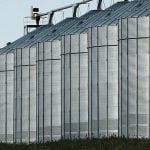Soybean and corn crops in Ontario are yielding better than expected, according to industry officials.
"We had quite a dry summer in Ontario so there were considerable concerns that the yields were not going to be there," said Horst Bohner, soybean specialist with the Ontario Ministry of Agriculture, Food and Rural Affairs in Guelph. "But on the whole the yields were better than expected."
Because conditions varied so greatly across the province, the range of yields for soybeans that were reported as of late October was "tremendous," he said.
Read Also

Prairie forecast: Active pattern continues with mostly-dry west, wet start for east
The active pattern that we saw last week looks to continue into this forecast period which means more chances for rain, possibly some wet snow and a continuation of the temperature rollercoaster ride.
"Some acres really did have severe dry conditions so we’ve heard of yields as low as 15 bushels per acre and as high as 80 bushels per acre."
Corn yields also showed a wide range due to differing weather conditions.
Greg Stewart, a corn specialist with OMAFRA at Guelph, said reports of yields as low as 30 bushels per acre and as high as 260 bushels per acre had come in as of Thursday.
Most corn- and soybean-growing regions did experience dry weather, but some were lucky enough to receive one or two timely rains that made the difference at harvest time, Bohner said.
As of Thursday, harvest progress across the province as a whole was about 80 per cent complete for soybeans, and 50 per cent for corn. Some regions were more or less advanced than that, however.
"As we got into harvest there was a good run at the crop in terms of harvesting and then it started to rain," Bohner said. "So, in the north, the harvest isn’t that far along, and (in) some of the areas that caught a little bit more sunshine, harvest is more advanced."
The better than expected yields will probably entice Ontario’s producers to plant another record-sized soybean crop in the spring, Bohner said.
Farmers across the province planted 2.65 million acres of soybeans in 2012-13, according to the latest production report from Statistics Canada.
Strong soybean prices will help influence producers to plant more soybeans for 2013-14 as well, though a lot of it will depend on corn prices and how much winter wheat is seeded this fall, Bohner said.
It’s still a little early to predict what corn acreage will be in the 2013-14 crop year, Stewart said, as it will also depend heavily on how much winter wheat gets put into the ground.
— Terryn Shiells writes for Commodity News Service Canada, a Winnipeg company specializing in grain and commodity market reporting.















